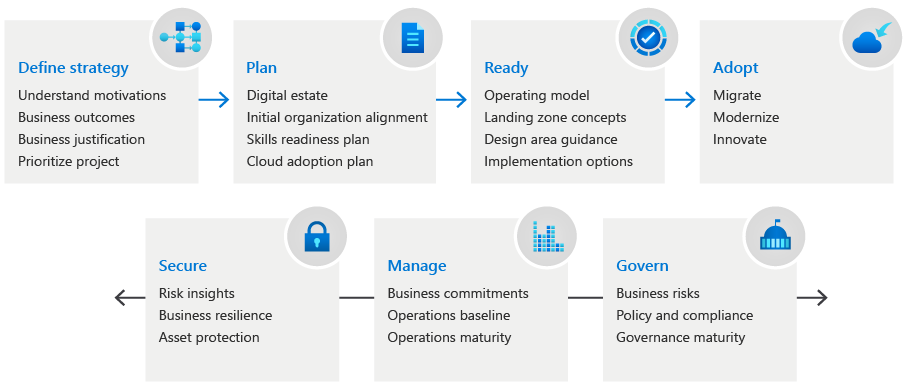Cloud is no longer a topic of the future – it’s today’s reality. Companies investing in modern IT infrastructures today do so for a clear reason: they want to become faster, more efficient and more resilient. But before migrating workloads, evaluating tools or calculating costs, there’s one central question to address: Why are we doing this at all – and what exactly do we want to achieve?
Welcome to the start of our blog series: Successful Migration & Modernization with the Microsoft Cloud Adoption Framework. And today we’re starting with the foundation of it all: strategy.
Why companies are moving to the cloud – and why it’s worth it
The reasons for cloud migration are as diverse as the companies themselves – but they all have one thing in common: they directly tie back to core business goals. Cost-efficiency is a frequently cited driver: cloud models allow for lower capital commitment, pay-as-you-go billing and better utilization of existing resources. Scalability and flexibility also play a key role – especially for companies facing fluctuating or growing demand.
In addition, modern cloud platforms open new opportunities for innovation – for example, by enabling easy access to technologies like AI, IoT or modern data services. Resilience and security are also not to be underestimated: the cloud offers higher availability, regular security updates and faster recovery options in case of outages. Finally, many companies are modernizing their IT landscape – replacing outdated systems, automating manual processes and optimizing their operating models.
In short: the question today is no longer whether to adopt cloud – but what for. Cloud migration is not an end in itself, but a strategic lever to achieve measurable business goals.
Defining Business Outcomes: Your Strategic Compass
Before starting a migration project, it must be clear what business value the cloud is expected to deliver. Microsoft calls these Business Outcomes – specific, measurable goals derived from overall company objectives.
Examples of Business Outcomes:
- Reduce costs: e.g., by consolidating data centers or improving license management
- Innovate faster: e.g., through DevOps-based releases or use of AI
- Reduce risks: e.g., by improving backup strategies or adopting higher security standards
- Enable growth: e.g., scaling into new markets or regions via global Azure infrastructure
👉 These goals help position the cloud project internally, win stakeholder support and later measure its success.
➡️ Tip: Develop these goals collaboratively with IT, management and business departments.
Which Workloads First?
A common mistake: “We’ll migrate everything.” Successful cloud adoption starts selectively – with the workloads that deliver real value quickly.
Criteria for selecting initial workloads:
- Low complexity or few dependencies
- High operational overhead in the current environment
- Ability to measure success quickly (quick wins)
- Team willingness to experiment with new operating models
➡️ Tip: A Cloud Readiness Assessment helps weigh technical and business criteria and create a migration prioritization.
Microsoft Cloud Adoption Framework: Structure for the Journey
Microsoft’s Cloud Adoption Framework is a practical roadmap that guides companies step by step into the cloud. It includes seven phases:

Microsoft Cloud Adoption Framework
- Define Strategy – Define goals and motivation
- Plan – Analyze current state, create a cloud roadmap
- Ready – Establish technical and organizational foundations
- Adopt – Implement migration and modernization
- Secure – Establish security, compliance and control
- Manage – Operate and optimize the new environment
- Govern – Keep rules, risks and policies under control
Each phase is supported by best practices, tools and templates – from defining goals to reaching operational maturity. In the coming weeks, we’ll explore each of these phases in this series.
🚀 Next Step: Assess Your Starting Point
Before developing a cloud roadmap, you need a realistic view of your current IT landscape. Where do you stand today? Which systems are cloud-ready, where is potential – and where are the technical or organizational risks?
The best way to start is with an Azure Cloud Readiness Assessment . This involves analyzing your existing IT environment, clarifying strategic goals, identifying dependencies and obstacles. Based on this, we prioritize initial workloads and define concrete next steps for your migration.
✅ Start with clarity: Our readiness check lays the foundation for a well-informed cloud strategy.
📅 Next Week: From Vision to Roadmap
How does a cloud vision become a concrete plan? In our next article, we’ll show you how to build a sustainable cloud roadmap based on your goals and your current IT landscape. You’ll learn which planning steps are essential, how to identify dependencies, and why a structured approach is the key to a successful migration. Stay tuned!
